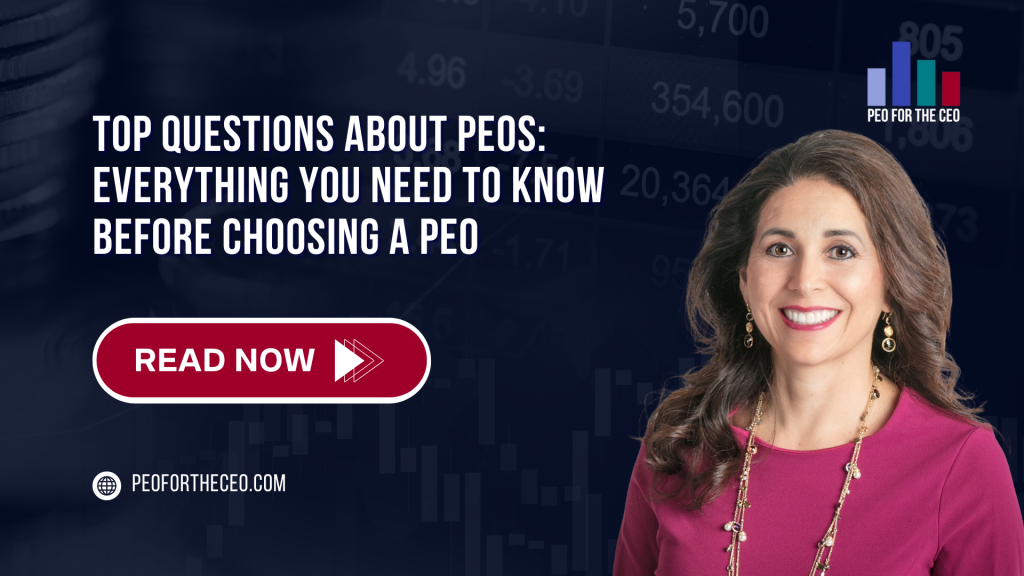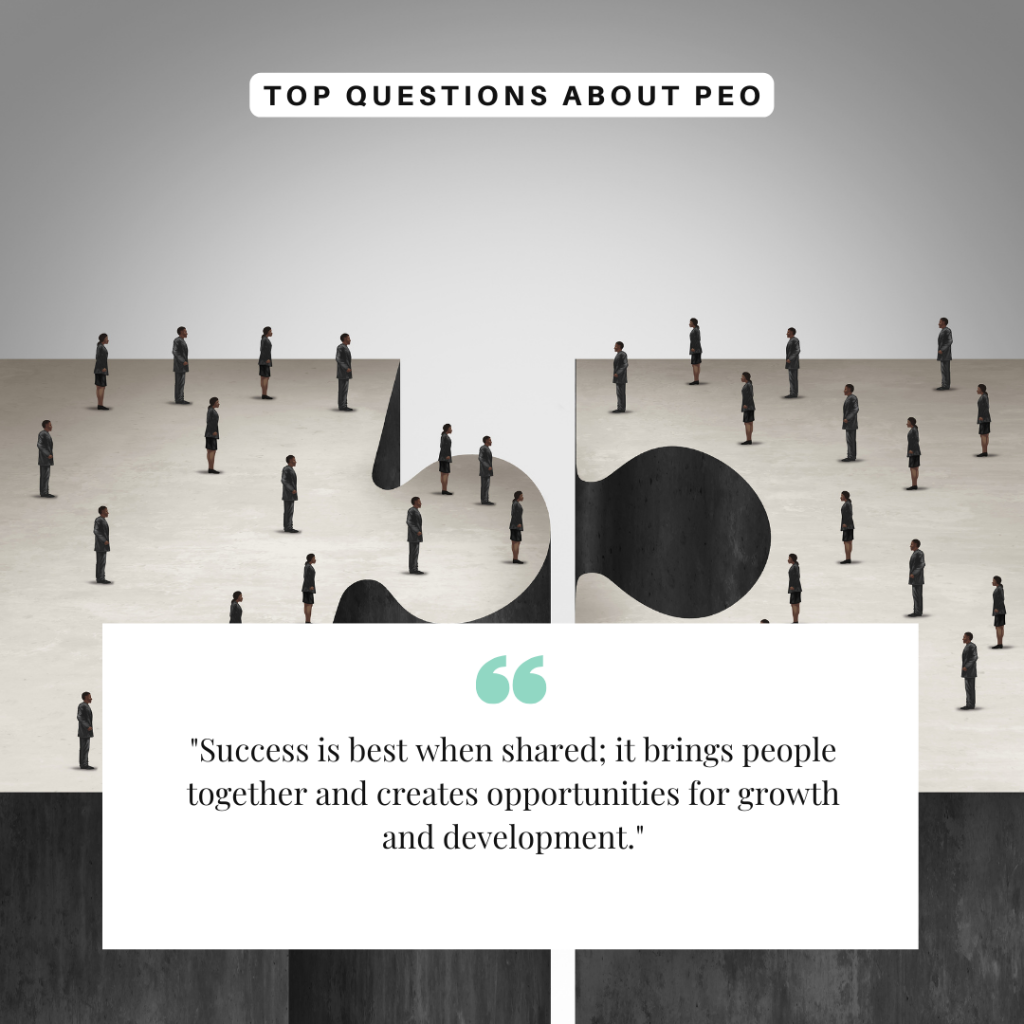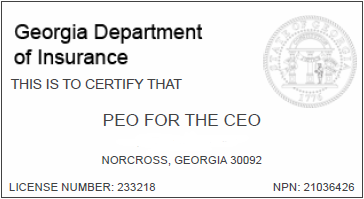Top Questions About PEOs: Everything You Need To Know Before Choosing A PEO

What Should We Consider When Looking at a New PEO Company?
1. Medical Plan Renewal Timing
- Each PEO has a different renewal cycle for their large group medical plan. It’s essential to know when this renewal happens, as it can impact on your rates. If you implement a PEO close to their renewal date, you may not benefit from a full 12-month rate lock.
2. Rate Lock & Negotiation
- If the PEO’s medical renewal is within 6 months of your implementation, it’s a good idea to negotiate in your service contract. Specifically, aim to cap any rate increase at no more than 9% for your medical insurance at the time of renewal. This helps provide predictability and protects you from significant cost hikes.
By considering the timing of the PEO’s medical plan renewal and negotiating your rate increase cap, you can better manage your costs and ensure stability in your benefits package.
How Do PEOs Handle Taxes If You Start Midyear?
When starting with a PEO midyear, it’s important to understand how they manage taxes, specifically:
1. FICA (Medicare and Social Security Taxes)
- A key consideration is whether the PEO will credit both you and your employer for Medicare and Social Security taxes that have already been paid during the current year. Without proper credits, you could end up overpaying these taxes, especially if you have already reached the annual wage cap for Social Security contributions.
2. SUTA (State Unemployment Taxes)
- Similarly, the PEO should ensure that state unemployment taxes (SUTA) are properly credited. Depending on when you join and your wages, you could be at risk of paying more than necessary if these taxes are not accounted for.
It’s essential to clarify with the PEO how they will handle tax credits for FICA and SUTA to avoid double taxation and ensure compliance. This is especially important if you’re starting midyear or have higher wages that are close to annual tax caps.
Why Are Credentials and Certifications Important for Selecting a PEO?
Credentials and certifications are essential when choosing a PEO because they offer assurance of credibility, compliance, and protection. Here are some key reasons why they matter:
1. Certified Professional Employer Organization (CPEO) Status
- PEOs that are certified by the IRS as a Certified Professional Employer Organization (CPEO) provide business owners with added protections and advantages. This certification ensures the PEO meets strict financial, tax, and reporting standards, giving you confidence in their operations.
2. National Association of PEOs (NAPEO) Membership & ESAC Accreditation
- Membership in NAPEO, combined with accreditation from the Employer Services Assurance Corporation (ESAC), offers a high level of security. ESAC accreditation is similar to FDIC protection for banks, and clients of accredited PEOs receive a bond that covers up to $16 million in case of any financial issues. Less than 3% of PEOs nationwide have earned both IRS and ESAC certifications, making this a significant marker of reliability.
3. SHRM Recertification Provider
- If your employees hold certifications from the Society for Human Resource Management (SHRM), working with a PEO that is an approved SHRM Recertification Provider adds further value. Employees can earn professional development credits (PDCs) through PEO-offered webinars and training, helping them maintain their SHRM certifications while benefiting your business with up-to-date HR expertise.
4. SSAE 18 SOC 1 Examination
- The SSAE TYPE II SOC 1 examination is a rigorous standard for evaluating how well a service organization manages its internal compliance controls, including financial reporting. PEOs that complete this independent CPA examination ensure their operational, compliance, and financial reporting processes are solid, providing you with objective evidence of their reliability and compliance with industry standards.
By selecting a PEO with these credentials and certifications, you ensure that your business is partnering with a professional, compliant, and secure organization, giving you peace of mind and protecting your company’s operations.
How do I know if I can exit my current contract?
I’m always happy to review your contract for you. In most cases, PEO companies require a 30, 60, or 90-day notice for termination without penalties. Additionally, if you’re experiencing service issues, there is often a clause that allows for termination “with cause” without penalties. Let me help you navigate this to ensure a smooth transition.
Timeline: How long should I anticipate for the implementation of a new PEO?
The implementation timeline varies based on the number of employees, but it’s typically recommended to allow 30 to 45 days for a smooth transition. This timeframe assumes you’ve already completed your due diligence, selected a suitable PEO partner, and signed the service agreement. Giving yourself this window ensures a more efficient and seamless onboarding process.
PEO Implementation Timeline
1. Kick-Off
- Sales Hand-off: Sales team introduces Implementation Specialist (I.S.) to the client.
- Kick-off Call: I.S. schedules and conducts a detailed kick-off call with the client.
2. Benefit Plan Review
- Meeting Scheduled: Insurance Agency Consultant schedules a meeting to review benefit plan offerings.
- Benefit Plan Approved: Client reviews and signs the Benefit Plan Offering (BPO).
- Enrollment Meeting: I.S. receives signed BPO and schedules a meeting to discuss the enrollment process and timeline.
3. Client Data Imported
- Company Data Submission: Client submits key data (worksite addresses, SUI notices, PTO policies, Chart of Accounts).
- Bank Setup: Reverse wire paperwork completed with the bank if applicable.
4. New Hire Onboarding
- Employee Data: Client provides completed employee import data file (using the PEO’s template).
- Onboarding Configuration: PEO configures and launches the new hire onboarding process.
- Onboarding Completion: Employees complete the onboarding process.
5. HRIS Training & Benefits Enrollment
- Manager Portal Training: PEO provides initial training on the Manager Portal (site navigation and employee record updates).
- Benefit Enrollment Begins: Employees enroll in benefit plans.
- Benefit Enrollment Ends: Elections are sent to carriers two weeks before the effective date.
6. Payroll Setup
- Bank Readiness Confirmed: Bank readiness for invoice payment is confirmed 2 days before the pay date (Direct Wire or ACH, depending on PEO guidelines).
- PTO Policies & Ledger Setup: PTO policies and General Ledger file details finalized in the system. PTO balances are loaded after the final pay date.
7. Mock Payroll & Payroll Training
- Mock Payroll: PEO conducts a mock payroll to confirm system readiness.
- Client Payroll Training: Online payroll training is conducted with the client.
8. First Payroll
- First Payroll Processed: The first payroll run is completed.
What Does a Good PEO Relationship Look Like?
A strong PEO relationship is built on proactive service, tailored support, and continuous communication. Here’s what you can expect from an ideal PEO partnership:
1. Strategic Needs Assessment & Service Plan
- A thorough assessment is conducted to understand your business needs.
- For smaller clients (up to 100 worksite employees), this is typically completed within 60 days after the first payroll; for larger clients (100+ employees), it’s completed within 45 days.
2. Open Enrollment Strategy & Process
- A well-organized open enrollment strategy is implemented, ensuring employees have a smooth experience selecting benefits.
- PEO-sponsored benefits are managed efficiently, with timelines and processes in place for seamless enrollment.
3. Client Directory & Account Manager Role
- After the initial assessment, a detailed client directory is provided, and the account manager’s role is reviewed.
- The first on-site visit is scheduled to foster a more personalized and hands-on approach to client management.
4. On-Site Leadership Meetings
- Regular on-site meetings are scheduled to maintain alignment with your business goals.
- These leadership meetings are scheduled quarterly to review progress, discuss any challenges, and ensure the PEO’s services are aligned with your evolving needs.
5. Compliance Support
- The PEO ensures you stay compliant with key laws and regulations, providing ongoing assistance with federal and state agency matters.
- Employment Practices Liability Insurance (EPLI) support is also available to help manage legal risks.
6. Training & Webinars
- The PEO offers ongoing support through individual client webinars, tailored to specific needs.
- Additionally, monthly webinars cover key HR topics to keep your team informed and up-to-date on best practices and compliance requirements.
7. Annual Review & Adjustments
- A strategic review is conducted annually in the fourth quarter to assess the effectiveness of the service plan and make necessary adjustments for the upcoming year.
- This helps ensure that the PEO continues to deliver value and meet your business objectives.

A good PEO relationship is defined by its responsiveness, strategic planning, and ability to adapt to your business’s changing needs, all while ensuring compliance and providing exceptional support.
With over 600 PEO companies, how do you choose? As your dedicated PEO broker, we take a holistic approach to finding the right PEO partner for your business, helping you maximize your savings potential and avoid any undue risks.
Ready to optimize your worker’s comp, and employee benefit plans and streamline your HR processes? Contact Suzanna@PEOfortheCEO.com today for personalized assistance or schedule a chat with us.


